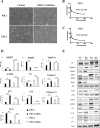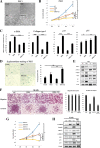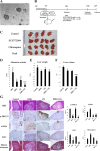Inhibition of ERK1/2 in cancer-associated pancreatic stellate cells suppresses cancer-stromal interaction and metastasis
- PMID: 31133044
- PMCID: PMC6537367
- DOI: 10.1186/s13046-019-1226-8
Inhibition of ERK1/2 in cancer-associated pancreatic stellate cells suppresses cancer-stromal interaction and metastasis
Abstract
Background: Extracellular signal-regulated kinases (ERKs) have been related to multiple cancers, including breast cancer, hepatocellular cancer, lung cancer and colorectal cancer. ERK1/2 inhibitor can suppress growth of KRAS-mutant pancreatic tumors by targeting cancer cell. However, no studies have shown the expression of ERK1/2 on pancreatic stromal and its effect on pancreatic cancer-stromal interaction.
Methods: Immunohistochemistry and western blotting were performed to detect the expression of p-ERK1/2 in pancreatic tissues and cells. Cell viability assay was used to study IC50 of ERK inhibitor on pancreatic cancer cells (PCCs) and primary cancer-associated pancreatic stellate cells (PSCs). Transwell migration, invasion, cell viability assay, senescence β-galactosidase staining were performed to determine the effect of ERK inhibitor on PCCs and PSCs in vitro and in vivo. The expression of key factors involved in autophagy and epithelial-to-mesenchymal transition (EMT) process were evaluated by western blotting. The expression of key factors related to cell invasiveness and malignancy were confirmed by qRT-PCR. Co-transplantation of PCC Organoid and PSC using a splenic xenograft mouse model was used to evaluated combined treatment of ERK inhibitor and autophagy inhibitor.
Results: Immunohistochemical staining in pancreatic tumor samples and transgenetic mice detected p-ERK1/2 expression in both cancer cells and stromal cells. In pancreatic tissues, p-ERK1/2 was strongly expressed in cancer-associated PSCs compared with cancer cells and normal PSCs. PSCs were also significantly more sensitive to ERK1/2 inhibitor treatment. Inhibition of ERK1/2 suppressed EMT transition in HMPCCs, upregulated cellular senescence markers, activated autophagy in cancer-associated PSCs; and suppressed cancer-stromal interaction, which enhanced invasiveness and viability of cancer cells. We also found that chloroquine, an autophagy inhibitor, suppressed ERK inhibition-induced autophagy and promoted PSC cellular senescence, leading to significantly decreased cell proliferation. The combination of an ERK inhibitor and autophagy inhibitor suppressed liver metastasis in a splenic pancreatic cancer organoid xenograft mouse model.
Conclusions: These data indicate that inhibition of ERK1/2 in cancer-associated pancreatic stellate cells suppresses cancer-stromal interaction and metastasis.
Keywords: Cancer–stromal interaction; Cellular senescence; ERK1/2; Pancreatic cancer; Pancreatic stellate cell.
Conflict of interest statement
The authors declare that they have no competing interests.
Figures








Similar articles
-
Galectin-3 Mediates Tumor Cell-Stroma Interactions by Activating Pancreatic Stellate Cells to Produce Cytokines via Integrin Signaling.Gastroenterology. 2018 Apr;154(5):1524-1537.e6. doi: 10.1053/j.gastro.2017.12.014. Epub 2017 Dec 21. Gastroenterology. 2018. PMID: 29274868
-
Autophagy Is Required for Activation of Pancreatic Stellate Cells, Associated With Pancreatic Cancer Progression and Promotes Growth of Pancreatic Tumors in Mice.Gastroenterology. 2017 May;152(6):1492-1506.e24. doi: 10.1053/j.gastro.2017.01.010. Epub 2017 Jan 23. Gastroenterology. 2017. PMID: 28126348
-
Calpain inhibitor calpeptin suppresses pancreatic cancer by disrupting cancer-stromal interactions in a mouse xenograft model.Cancer Sci. 2016 Oct;107(10):1443-1452. doi: 10.1111/cas.13024. Epub 2016 Sep 24. Cancer Sci. 2016. PMID: 27487486 Free PMC article.
-
Dangerous liaisons: pancreatic stellate cells and pancreatic cancer cells.J Gastroenterol Hepatol. 2012 Mar;27 Suppl 2:69-74. doi: 10.1111/j.1440-1746.2011.07000.x. J Gastroenterol Hepatol. 2012. PMID: 22320920 Review.
-
Pancreatic stellate cell: Pandora's box for pancreatic disease biology.World J Gastroenterol. 2017 Jan 21;23(3):382-405. doi: 10.3748/wjg.v23.i3.382. World J Gastroenterol. 2017. PMID: 28210075 Free PMC article. Review.
Cited by
-
From Genetic Alterations to Tumor Microenvironment: The Ariadne's String in Pancreatic Cancer.Cells. 2020 Jan 28;9(2):309. doi: 10.3390/cells9020309. Cells. 2020. PMID: 32012917 Free PMC article. Review.
-
STING activator 2'3'-cGAMP enhanced HSV-1-based oncolytic viral therapy.Mol Oncol. 2024 May;18(5):1259-1277. doi: 10.1002/1878-0261.13603. Epub 2024 Feb 23. Mol Oncol. 2024. PMID: 38400597 Free PMC article.
-
DNA Polymerase Theta Plays a Critical Role in Pancreatic Cancer Development and Metastasis.Cancers (Basel). 2022 Aug 23;14(17):4077. doi: 10.3390/cancers14174077. Cancers (Basel). 2022. PMID: 36077614 Free PMC article.
-
The Role and Mechanism of Autophagy in Pancreatic Cancer: An Update Review.Cancer Manag Res. 2021 Nov 2;13:8231-8240. doi: 10.2147/CMAR.S328786. eCollection 2021. Cancer Manag Res. 2021. PMID: 34754243 Free PMC article. Review.
-
Corema album Leaves Mediate DNA Damage in Triple-Negative Breast Cancer Cells.Curr Issues Mol Biol. 2022 Aug 11;44(8):3598-3610. doi: 10.3390/cimb44080246. Curr Issues Mol Biol. 2022. PMID: 36005142 Free PMC article.
References
-
- Stewart BW, Wild CP. World cancer report 2014. World Heal Organ [Internet] 2014;1–2. Available from: https://www.who.int/cancer/publications/WRC_2014/en/.
-
- Howlader N, Noone AM, Krapcho M et al. SEER Cancer Statistics Review, 1975–2013. Natl Cancer Institute Bethesda, MD [Internet]. 2016. Available from: http://seer.cancer.gov/csr/1975_2013/.
-
- Neesse A, Michl P, Frese KK, Feig C, Cook N, Jacobetz MA, et al. Stromal biology and therapy in pancreatic cancer. Gut. 2011. - PubMed
MeSH terms
Substances
LinkOut - more resources
Full Text Sources
Medical
Research Materials
Miscellaneous

